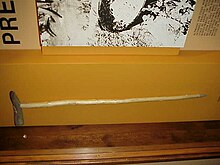Primitive Technology/Digging Stick
A digging stick is a wooden tool used to dig out underground tubers, burrowing animals, and anthills. They were also used by agrarian societies for farming.

Numerous indigenous cultures across multiple continents are known for using digging sticks, most notably the Aztecs, Ethiopians, and the prehistoric inhabitants of New Guinea.[1] The Hadza, a modern African hunter-gatherer ethnic group, continue to utilize digging sticks in the present day. Contemporary survivalists have also experimented with digging sticks.
Due to the decomposing nature of wood, digging sticks are rare in the archaeological record.
Description
editDimensions
editTypical digging sticks ranged from two to three feet in length, with the bottom tip shaved off at an angle.[2]
The size of digging sticks could be variable, and they may have been adjusted to the height of the user. In New Guinea, archaeologists found that women may have used shorter sticks than men.[3]
Types
editFire Hardened Tip
editFor some digging sticks, fire hardening was employed to strengthen the tip.
Handle
editFor some digging sticks, a cross-piece would be fit perpendicularly over the top of the stick, allowing the use of two hands to manipulate the tool into the ground.
In some instances, the handle could be decorated ceremonially.
History
editNon-Human Primates
editChimpanzees have been documented using wooden implements for purposes similar to digging.
They insert sticks into ant, bee, and termite nests to probe and fish for insects. Chimpanzees eat ants and honey as part of their diet.[4]
Mesolithic Period
editDigging sticks have been definitely recovered in the archaeological record since the mesolithic period. Notable archaeological sites include:
References
edit- ↑ "Digging stick". Wikipedia. 2018. https://en.wikipedia.org/wiki/Digging_stick. Retrieved 2019-08-03.
- ↑ Binus, Joshua (2004). "Plateau Culture Digging Stick". Oregonhistoryproject.org. Oregon Historical Society. Retrieved 2019-08-04.
- ↑ a b Jack, Golson. "Chapter 19 Artefacts of Wood". Ten Thousand Years of Cultivation at Kuk Swamp in the Highlands of Papua New Guinea. ANU Press. pp. 359–372. ISBN 978-1-76046-116-4. Retrieved 2019-08-03.
- ↑ Boesch C, Boesch H. (1990). "Tool Use and Tool Making in Wild Chimpanzees" (PDF). Folia Primatologica. 54: 86–99. doi:10.1159/000156428.
- ↑ Taylor, Maisie. "Chapter 29 The Wooden Artefacts". Star Carr: Studies in Technology, Subsistence and Environment. White Rose University Press. pp. 367–418. ISBN 978-1-912482-01-6. Retrieved 2019-08-04.